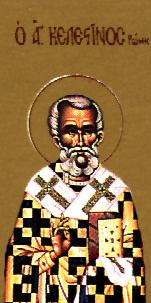Difference between revisions of "Celestine of Rome"
(Add more) |
m (links) |
||
| Line 1: | Line 1: | ||
[[Image:0408celestine-rome.jpg|thumb|right|Saint Celestine, Pope of Rome]] | [[Image:0408celestine-rome.jpg|thumb|right|Saint Celestine, Pope of Rome]] | ||
| − | [[Saint]] '''Celestine of Rome''' held [[Pope|papal]] authority from 422 - 432. During his papacy, the saint strongly defended the [[Church]] and denounced the Nestorian heresy. He is remembered on April 8 in the east and April 6 in the west. | + | [[Saint]] '''Celestine of Rome''' held [[Pope|papal]] authority from 422 - 432. During his papacy, the saint strongly defended the [[Church]] and denounced the Nestorian heresy. He is remembered on [[April 8]] in the east and [[April 6]] in the west. |
==Life== | ==Life== | ||
Saint Celestine, a zealous champion of Orthodoxy, lived during the reign of the holy Emperor Theodosius the Younger (408-450). He received an excellent education, and he was known for his extensive knowledge of the [[Holy Scripture]] and his theological ponderings. | Saint Celestine, a zealous champion of Orthodoxy, lived during the reign of the holy Emperor Theodosius the Younger (408-450). He received an excellent education, and he was known for his extensive knowledge of the [[Holy Scripture]] and his theological ponderings. | ||
| − | The virtuous life of the [[saint]] and his authority as a theologian won him the general esteem and love of the clergy and people. After the death of St Boniface I, St Celestine was chosen to be the [[Bishop]] of [[Church of Rome|Rome]]. | + | The virtuous life of the [[saint]] and his authority as a [[theologian]] won him the general esteem and love of the [[clergy]] and people. After the death of St Boniface I, St Celestine was chosen to be the [[Bishop]] of [[Church of Rome|Rome]]. |
A strong character, Saint Celestine was active against [[pelagianism]], he sent St. Germanus of Auxerre to Britain and St. Palladius to Ireland. | A strong character, Saint Celestine was active against [[pelagianism]], he sent St. Germanus of Auxerre to Britain and St. Palladius to Ireland. | ||
| − | During this time, the [[heresy]] of [[Nestorius]] emerged. At a local Council in Rome in 430, St Celestine denounced this heresy and condemned Nestorius as a heretic. After the Council, St Celestine wrote a letter to St [[Cyril of Alexandria|Cyril, Archbishop of Alexandria]] (January 18), stating that if Nestorius did not renounce his false teachings after ten days, then he should be deposed and excommunicated. | + | During this time, the [[heresy]] of [[Nestorius]] emerged. At a local Council in Rome in 430, St Celestine denounced this [[heresy]] and condemned Nestorius as a [[heretic]]. After the Council, St Celestine wrote a letter to St [[Cyril of Alexandria|Cyril, Archbishop of Alexandria]] ([[January 18]]), stating that if Nestorius did not renounce his false teachings after ten days, then he should be deposed and excommunicated. |
St Celestine also sent a series of letters to other churches, [[Constantinople]] and [[Antioch]], in which he unmasked and denounced the Nestorian heresy. | St Celestine also sent a series of letters to other churches, [[Constantinople]] and [[Antioch]], in which he unmasked and denounced the Nestorian heresy. | ||
Revision as of 20:15, December 29, 2007
Saint Celestine of Rome held papal authority from 422 - 432. During his papacy, the saint strongly defended the Church and denounced the Nestorian heresy. He is remembered on April 8 in the east and April 6 in the west.
Life
Saint Celestine, a zealous champion of Orthodoxy, lived during the reign of the holy Emperor Theodosius the Younger (408-450). He received an excellent education, and he was known for his extensive knowledge of the Holy Scripture and his theological ponderings.
The virtuous life of the saint and his authority as a theologian won him the general esteem and love of the clergy and people. After the death of St Boniface I, St Celestine was chosen to be the Bishop of Rome.
A strong character, Saint Celestine was active against pelagianism, he sent St. Germanus of Auxerre to Britain and St. Palladius to Ireland.
During this time, the heresy of Nestorius emerged. At a local Council in Rome in 430, St Celestine denounced this heresy and condemned Nestorius as a heretic. After the Council, St Celestine wrote a letter to St Cyril, Archbishop of Alexandria (January 18), stating that if Nestorius did not renounce his false teachings after ten days, then he should be deposed and excommunicated.
St Celestine also sent a series of letters to other churches, Constantinople and Antioch, in which he unmasked and denounced the Nestorian heresy.
For two years after the Council, St Celestine proclaimed the true teaching about Christ the God-Man, and he died in peace on April 6, 432.
| Celestine of Rome | ||
|---|---|---|
| Preceded by: St Boniface I |
Pope of Rome 422-432 |
Succeeded by: St Sixtus III |
Categories > Church History
Categories > Church History
Categories > Church History
Categories > Church History
Categories > Liturgics > Feasts
Categories > Liturgics > Feasts
Categories > Liturgics > Feasts
Categories > Liturgics > Feasts
Categories > People > Clergy > Bishops
Categories > People > Clergy > Bishops
Categories > People > Clergy > Bishops > Bishops by century > 5th-century bishops
Categories > People > Clergy > Bishops > Bishops by city > Popes of Rome
Categories > People > Saints
Categories > People > Saints > Italian Saints
Categories > People > Saints > Pre-Schism Western Saints
Categories > People > Saints > Saints by century > 5th-century saints
